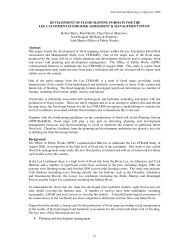COMMENT ON ESTIMATION OF GREENFIELD RUNOFF RATES ...
COMMENT ON ESTIMATION OF GREENFIELD RUNOFF RATES ...
COMMENT ON ESTIMATION OF GREENFIELD RUNOFF RATES ...
Create successful ePaper yourself
Turn your PDF publications into a flip-book with our unique Google optimized e-Paper software.
National Hydrology Seminar 2003<br />
Tony Cawley<br />
The overall accuracy of this method at small scales has not been extensively tested and similar to all<br />
other estimation methods at these scales the caveat should read “to be used as a guideline indicator<br />
only”.<br />
3.3 Flood Frequency Methods<br />
These methods use certain catchment descriptors to determine an index flood magnitude, such as the<br />
annual maximum flood (FSR methods) or median Flood (FEH method), which can then be multiplied<br />
by an appropriate regional flood frequency growth factor to yield a return period flood estimate (i.e.<br />
Q 100 ). A variety of empirical equations for various catchment regions (Benson (1962), Nash &<br />
Shaw(1966)) were available in UK prior to the publication of the Flood Studies Report (FSR) in 1975.<br />
The Office of Public Works prior to the FSR equations occasionally used formulae (Lynn, 1971) such<br />
as<br />
Q = 10.68 A 2/3 S 1/2 (eqn 9)<br />
Q = 190 A 3/4 S 1/4 R N 1/5 (eqn 10)<br />
These equations were converted into SI units with Q the design flood in cumec, A the catchment area<br />
in km 2 , S the median overland slope, R is the most frequently occurring maximum daily rainfall (mm)<br />
per annum and N is discharge return period (years). The first equation was considered to give<br />
satisfactory discharges, of about one to two year return period for small catchments (less than 2000<br />
acres (≈ 800 ha) ) of moderate slope. The other gives roughly equivalent results for these conditions<br />
but can be used more generally for defined frequencies.<br />
The flood estimation methods presented in this section progress from the original 1975 FSR equations<br />
to the 1978 FSSR Report No. 6 revision for small catchments, to the Institute of Hydrology No. 124<br />
equations for small catchments (which is now widely used in Ireland for estimation of greenfield<br />
runoff) and finally to the recent Flood Estimation Handbook FEH (1999) method, which is specific to<br />
the UK.<br />
3.3.1 1975 Flood Studies Report Catchment Characteristic Method<br />
The original 1975 FSR investigation involved flood frequency analysis of some 5500 record years<br />
from 430 British gauging stations and 1700 record years from 112 Irish sites. The catchment areas<br />
varied from 0.05 to 9868km 2 and annual maximum flows from 0.06 to 997cumec. Cunnane and Lynn<br />
(1976) provide a detailed examination of flood estimation in Ireland following the 1975 FSR.<br />
The FSR six-variable equation for the mean annual maximum flood Q BAR is<br />
Q BAR = C AREA 0.95 F S 0.22 SOIL 1.18 SAAR 1.05 S 1085 0.16 (1+LAKE) -0.93 (eqn 11)<br />
where the multiplier C = 0.00042 for Ireland. This equation has a standard factorial error of about 1.5.<br />
The three parameter equation for the same data set gives<br />
Q BAR = 4.53 x 10 -7 AREA 0.84 F S<br />
0.51<br />
SAAR 1.34 (eqn 12)<br />
and has a standard factorial error of 1.77.<br />
The two-variable equation for the same data set gives<br />
Q BAR = 2.242 x 10 -7 AREA 0.84 SAAR 2.09 (eqn 13)<br />
and has a standard factorial error of 1.96.<br />
Single-variable equation is<br />
Q BAR = 0.667AREA 0.77 (eqn 14)<br />
34

















